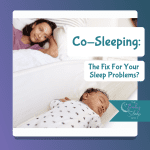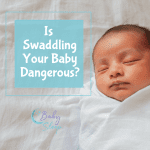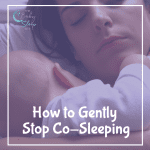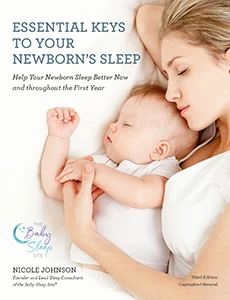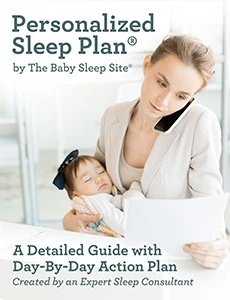
There’s been a popular debate going on for many years… The debate is over co-sleeping. A popular USA Today article fueled the fire by referencing a study that found that while the number of SIDS-related deaths has dropped by over 50% in the past two decades (since the introduction of the “Back to Sleep” campaign in 1994 began discouraging tummy sleeping), the drop has plateaued recently. What’s more, the number of SIDS-related deaths as a result of co-sleeping was actually on the rise. There’s no doubt that co-sleeping is a controversial topic, with parents offering strong and emotional opinions on both sides. Reports like the one in USA Today seem to indicate that co-sleeping is dangerous. But co-sleeping advocates point to research showing that it’s safe. So what do we make of this? Is co-sleeping dangerous? Should you and your baby co-sleep?
Defining Our Terms: Co-Sleeping vs. Room Sharing vs. Bed-Sharing
First, let’s get our terms straight. Co-sleeping simply means that a child shares a sleeping space with a parent. With that in mind, co-sleeping can mean a baby sleeping in the same bed as his parents. However, it can also mean a baby in a bassinet next to the bed. The American Academy of Pediatrics (AAP) calls that kind of sleeping arrangement “room-sharing”. Room-sharing is considered completely safe, as long as baby’s sleeping area follows safety guidelines. (No loose bedding, firm mattress that’s flush with the sides of the bassinet, tight-fitting bottom sheet, etc.) Bed-sharing refers to the practice of parents and children sharing the same bed. Bed-sharing (specifically when infants are involved) carries far more risks than other forms of co-sleeping.
Is Co-Sleeping Dangerous?
Room-sharing is safe. Bed-sharing, however, is inherently risky, specifically when it involves young infants. As rates of bed-sharing continue to rise in the United States, so do the rates of infant deaths related to bed-sharing. The most obvious danger related to bed-sharing is suffocation. An adult (or an older child) can roll on top of a baby, or the baby can be smothered by the large pillows and heavy blankets that most adults use in bed. Some less obvious dangers include a baby falling from the mattress to the floor, or a baby becoming wedged between the mattress and the headboard/footboard or wall. The mattress itself can also be a threat. If it’s overly soft, a baby can sink too low and suffocate.
As a growing number of babies die due to bed-sharing, health organizations are stepping up their efforts to warn parents. The AAP, along with the Consumer Product Safety Commission (CPSC), has issued precautions against bed-sharing, warning parents that it puts babies at a much higher risk of suffocation. And warnings like these aren’t just happening on a national scale. They’re happening at the local level, too. Bed-sharing was blamed for causing increasing rates of infant death in Milwaukee, WI, so the city’s health department responded by releasing a highly controversial ad depicting a baby curled up (in an adult bed) next to a large butcher knife. When critics attacked the ad as extreme (and it is), Milwaukee’s Commissioner of Health replied, “…what is even more shocking and provocative is that 30 developed and underdeveloped countries have better [infant death] rates than Milwaukee.”
Can Co-Sleeping Be Safe?
Again, room-sharing arrangements are considered very safe. In fact, the AAP recommends room-sharing as the best sleeping arrangement for infants, since it’s been shown to produce lower rates of SIDS than a solitary sleeping arrangement (which places baby in a room by herself.) And while bed-sharing is statistically less safe, advocates of bed-sharing point out that research studies (like the one cited in the USA Today article) fail to account for a variety of factors and ultimately make bed-sharing seem more dangerous than it actually is.
For example, researchers refer to bed-sharing as a baby and an adult sharing an “adult bed.” But an adult bed doesn’t necessarily mean an actual bed — in these studies, it can also mean a couch, or a recliner, or a waterbed (all surfaces that bed-sharing advocates would never recommend using). Research studies also fail to account for safety factors like smoking, or drug and alcohol abuse (parents who smoke or use drugs or alcohol should never bed-share.) Even factors like obesity, which advocates say should be considered (since obese parents are advised not to bed-share), aren’t considered in research studies.
Supporters say:
Supporters of bed-sharing claim that when these factors are considered, research shows that safe bed-sharing practices make putting a baby to sleep in an adult bed just as harmless as putting a baby to sleep in a crib. One study indicates that when researchers controlled for these kinds of safety factors, rates of infant death proved to be very low.
A study published in 2013 reveals that any kind of bed-sharing, even safe bed-sharing, increases an infant’s risk of SIDS five-fold. The study’s researchers found that even in the safest settings, bed-sharing presents a dramatic increase in the risk of SIDS. This stands in direct opposition to the earlier study which found that safe bed-sharing produces low rates of infant death.
Supporters of co-sleeping also point to the fact that co-sleeping in all its forms (including bed-sharing) has been the norm for human infants since the dawn of time, while putting babies in cribs, in their own rooms, alone, is a practice that’s less than 200 years old. Anthropologist Dr. James McKenna, an outspoken advocate of co-sleeping, points to these facts as proof that mothers and babies are biologically designed to sleep together, and he asserts that co-sleeping is the best sleeping arrangement for families.
Additionally:
Bed-sharing advocates emphasize that while co-sleeping is no longer standard practice in most Western cultures, it remains the norm in many, many countries around the world. These advocates are quick to point out that if it works for families around the globe, it can work for families in the West.
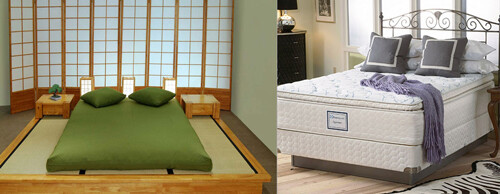
An important note, though, about comparing bed-sharing in Western countries to bed-sharing around the world. The comparison isn’t always a fair one. Western-style beds (with their soft, elevated mattresses as shown above, and their abundance of pillows and blankets) make bed-sharing more dangerous than other types of beds found around the world. What’s more, health-habits vary worldwide, making the bed-sharing comparison a tricky one. Western mothers are more likely to smoke than are Japanese mothers, for example. This may partly explain why Japan has an extremely low rate of deaths related to bed-sharing. It’s best to take cultural differences like this into account when looking at bed-sharing from an international perspective.
Should You Co-Sleep Or Not?
Putting a baby to bed is a bit like stepping into a car. There are risks associated with driving, and traveling in a car can certainly kill you. But there are many steps you can take to make driving safe, like wearing a seat belt, obeying traffic signs, and taking proper care of your vehicle. Baby sleep can work the same way. There are risks associated with any sleeping arrangement. But parents can take steps to make their baby’s sleep environment as safe as possible.
Parents who educate themselves and practice safe co-sleeping shouldn’t be made to feel guilty about their decision. And of course, neither should parents who choose not to co-sleep. After all, it won’t work for everyone! That was certainly the case with Nicole. During the time she co-slept, she found herself so worried about her son that she hardly slept at all.
A Final Word:
While many forms of co-sleeping are safe, bed-sharing is inherently risky. There are ways to bed-share safely. The list of precautions is long, and some of the precautions themselves border on extreme. For example, it’s recommended that you remove pillows and blankets from the bed and that you put your mattress directly on the floor. It’s also safest if the only people in bed are mom and baby. This means that if dad is around, he needs to find somewhere else to sleep!
What’s more, safety guidelines specify that some people shouldn’t bed-share. This includes those who smoke and use drugs/alcohol, those who are obese, and those who are “overly exhausted.” That last one is bound to exclude many readers of this blog! If you’re considering bed-sharing, remember to review the list of precautions carefully, and then commit to following them. Otherwise, we recommend that you consider a different method of co-sleeping.

